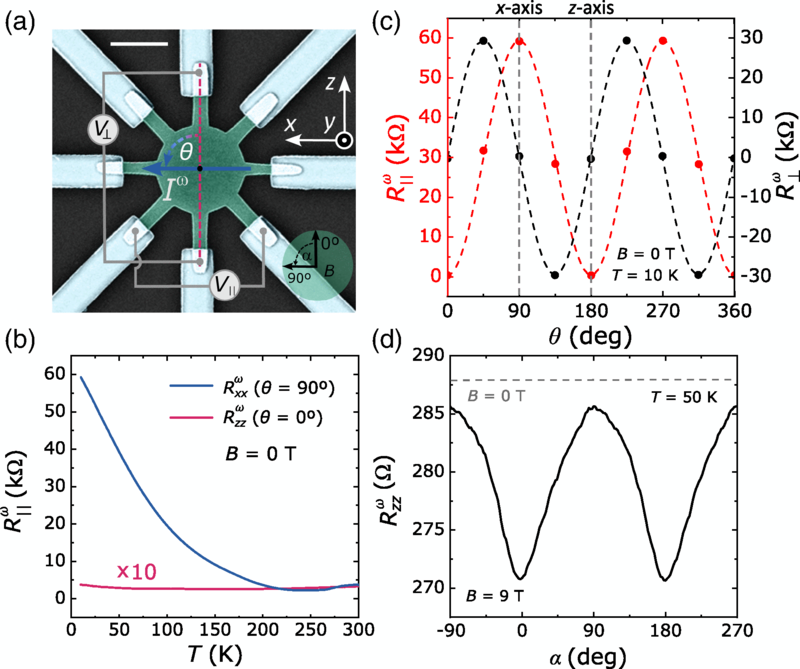An odd nonlinear conductivity in chiral tellurium
Electrical transport in non-centrosymmetric materials departs from the well-established phenomenological Ohm’s law. Instead of a linear relation between current and electric field, a non-linear conductivity emerges along specific crystallographic directions. This non-linear transport is fundamentally related to the lack of spatial inversion symmetry.
Ohm’s law is one of the most established relations in Physics and forms the basis of today’s electronics. This phenomenological relation states that the charge current density in a material is linearly proportional to the applied electric field. Under time-reversal symmetry conditions, most conducting materials follow this correlation down to the nanoscale, with a constant of proportionality which is the electrical conductivity of the system.
However, and starting from recent seminal studies in WTe2, different experimental and theoretical reports showed that, in systems with broken inversion symmetry, a non-linear charge current quadratically proportional to the applied electric field is allowed. In this case, the proportionality is captured by the non-linear susceptibility tensor of the system, which depends on the symmetry of the material and may present both diagonal and off-diagonal components. Diagonal components, which are associated to the non-linear longitudinal conductivity and are purely connected to extrinsic mechanisms. These components could lead to strong non-linear output signals promising for applications in frequency-doubling, energy harvesting and wireless detection via rectification.
Since breaking inversion symmetry is the fundamental requirement for the emergence of non-linear transport, an inversion symmetry (i) operation is expected to profoundly affect the non-linear conductivity. Chiral materials have neither mirror planes nor inversion centres, and are, therefore, non-centrosymmetric. Unlike trivial rotations, i results in a change of handedness. In spite of their importance to test the effect of i, non-linear conductivity has not been explored in any chiral material. In this regard, chiral elemental tellurium, which can be synthesized as single crystalline flakes with both handedness and excellent electronic properties, represent an ideal platform to disentangle the effect of i and rotation on the non-linear transport.

Now, a team of researchers reports 1 the observation of a large non-linear conductivity in chiral single crystalline tellurium flakes. The dependence of this non-linear effect on the relative orientation between the crystallographic axes of tellurium and the current direction is fully explained by symmetry considerations, as it arises from the non-linear susceptibility tensor of the space group of tellurium.
By performing measurements on tellurium flakes with opposite handedness, the researchers experimentally demonstrate that i changes the sign of the non-linear tensor, in agreement with its spatial-inversion-odd nature. The resistivity dependence of the non-linear conductivity shows that side-jump scattering is its dominant microscopic mechanism.
The electrostatic gating of the tellurium flakes allows tuning its non-linear response by a factor of 300, reaching a non-linear voltage of up to 1.2 mV. This strong output signal is the highest reported excluding engineered heterostructures. These results establish chiral tellurium as an ideal compound not just to study the fundamental interplay between crystal structure, symmetry operations and non-linear transport; but also to develop wireless rectifiers and energy-harvesting chiral devices.
Author: César Tomé López is a science writer and the editor of Mapping Ignorance
Disclaimer: Parts of this article may have been copied verbatim or almost verbatim from the referenced research paper/s.
References
- Manuel Suárez-Rodríguez, Beatriz Martín-García, Witold Skowroński, F. Calavalle, Stepan S. Tsirkin, Ivo Souza, Fernando De Juan, Andrey Chuvilin, Albert Fert, Marco Gobbi, Fèlix Casanova, and Luis E. Hueso (2024) Odd Nonlinear Conductivity under Spatial Inversion in Chiral Tellurium Phys. Rev. Lett. doi: 10.1103/PhysRevLett.132.046303 ↩